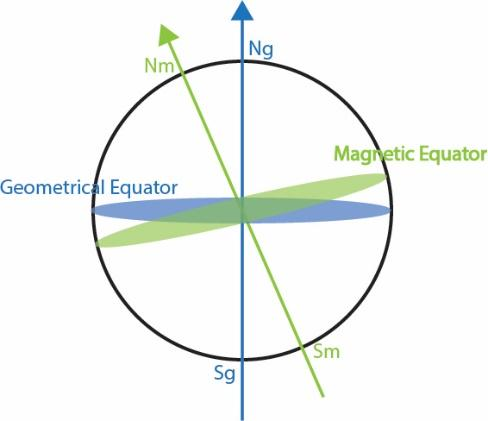
The angle between the magnetic meridian and the geographical meridian is known as
(A). Magnetic pole strength
(B). Magnetic dip
(C). Magnetic declination
(D). Magnetic moment
Answer
499.5k+ views
- Hint: Try to determine which of the quantities in the option associates with magnetic and geographical meridian, particularly the angle between them. The geographical meridian and the magnetic meridian are the axis drawn from the geographical North to South and magnetic North to South respectively.
Complete step-by-step solution -
For the planet earth it was observed that the magnetic poles do not coincide with the geographical poles. If an imaginary axis is imagined along the north end to south end of a magnetized compass needle point, which corresponds to the direction of the Earth's magnetic field lines and another axis is imagined along the geographical north pole to south pole, the two axes are inclined with the other at an angle.
Magnetic declination is also known as magnetic variation and it is defined as the angle on the horizontal plane between magnetic north and true north. Depending upon the position on earth's surface and time, the angle changes its value..
Bowditch defined variation as “the angle between the magnetic and geographic meridians at any place, expressed in degrees and minutes east or west to indicate the direction of magnetic north from true north.”
Therefore, the correct answer to this question is option C. Magnetic declination.

Note: Do not get confused by similar terms in the options. Option A. Magnetic pole strength is the strength of a magnetic pole to attract magnetic materials towards itself. Option B. Magnetic dip Magnetic dip is the angle that a magnetic needle makes with the horizontal plane at any specific location. It is also known as magnetic inclination. Whereas, Option D. Magnetic moment makes an object have mechanical moment in an applied magnetic field.
Complete step-by-step solution -
For the planet earth it was observed that the magnetic poles do not coincide with the geographical poles. If an imaginary axis is imagined along the north end to south end of a magnetized compass needle point, which corresponds to the direction of the Earth's magnetic field lines and another axis is imagined along the geographical north pole to south pole, the two axes are inclined with the other at an angle.
Magnetic declination is also known as magnetic variation and it is defined as the angle on the horizontal plane between magnetic north and true north. Depending upon the position on earth's surface and time, the angle changes its value..
Bowditch defined variation as “the angle between the magnetic and geographic meridians at any place, expressed in degrees and minutes east or west to indicate the direction of magnetic north from true north.”
Therefore, the correct answer to this question is option C. Magnetic declination.

Note: Do not get confused by similar terms in the options. Option A. Magnetic pole strength is the strength of a magnetic pole to attract magnetic materials towards itself. Option B. Magnetic dip Magnetic dip is the angle that a magnetic needle makes with the horizontal plane at any specific location. It is also known as magnetic inclination. Whereas, Option D. Magnetic moment makes an object have mechanical moment in an applied magnetic field.
Recently Updated Pages
Master Class 12 Economics: Engaging Questions & Answers for Success

Master Class 12 Maths: Engaging Questions & Answers for Success

Master Class 12 Biology: Engaging Questions & Answers for Success

Master Class 12 Physics: Engaging Questions & Answers for Success

Master Class 12 Business Studies: Engaging Questions & Answers for Success

Master Class 12 English: Engaging Questions & Answers for Success

Trending doubts
Draw a labelled sketch of the human eye class 12 physics CBSE

The final image formed by a compound microscope is class 12 physics CBSE

Differentiate between homogeneous and heterogeneous class 12 chemistry CBSE

What are the major means of transport Explain each class 12 social science CBSE

Which of the following properties of a proton can change class 12 physics CBSE

Sum of two skew symmetric matrices is always matri class 12 maths CBSE




